rhetorical fallacies(英语修辞与写作lecture 5)
- 格式:ppt
- 大小:328.00 KB
- 文档页数:21
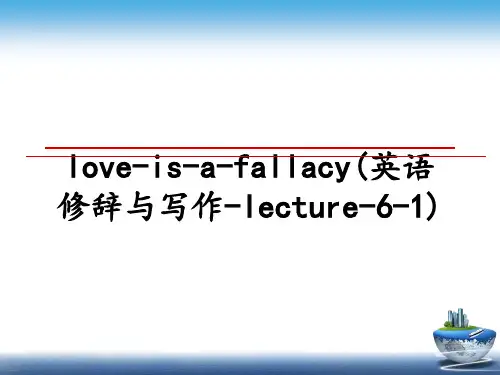
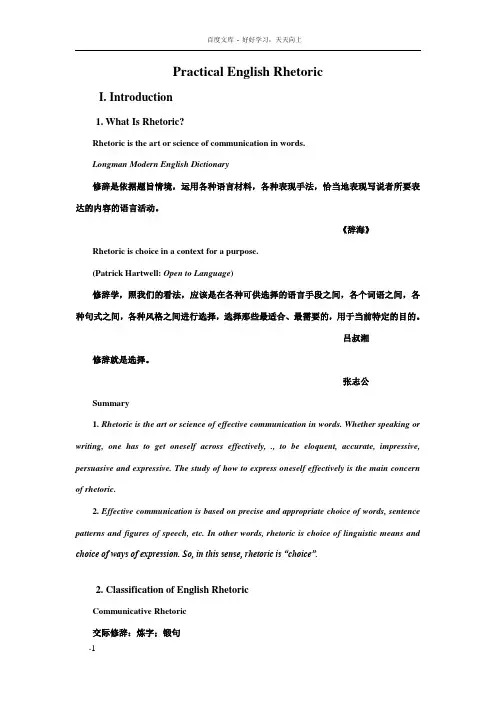
Practical English RhetoricI. Introduction1. What Is Rhetoric?Rhetoric is the art or science of communication in words.Longman Modern English Dictionary修辞是依据题旨情境,运用各种语言材料,各种表现手法,恰当地表现写说者所要表达的内容的语言活动。
《辞海》Rhetoric is choice in a context for a purpose.(Patrick Hartwell: Open to Language)修辞学,照我们的看法,应该是在各种可供选择的语言手段之间,各个词语之间,各种句式之间,各种风格之间进行选择,选择那些最适合、最需要的,用于当前特定的目的。
吕叔湘修辞就是选择。
张志公Summary1. Rhetoric is the art or science of effective communication in words. Whether speaking or writing, one has to get oneself across effectively, ., to be eloquent, accurate, impressive, persuasive and expressive. The study of how to express oneself effectively is the main concern of rhetoric.2. Effective communication is based on precise and appropriate choice of words, sentence patterns and figures of speech, etc. In other words, rhetoric is choice of linguistic means and choice of ways of expression. So, in this sense, rhetoric is “choice”.2. Classification of English RhetoricCommunicative Rhetoric交际修辞:炼字;锻句Aesthetic Rhetoric美学修辞:各种修辞格Communicative rhetoric lays particular stress on lexical accuracy, structural meticulousness and contextual appropriateness so as to bring its linguistic communicative role into full play.Example (1)She sat at the window watching the evening invade the avenue. Her head was leaned against the window curtains and in her nostrils was the odor of dusty cretonnes.She was tired.(James Joyce: “Eveline”) Example (2)Dick Boulton looked at the doctor. Dick was a big man. He knew how big a man he was. He liked to get into fights. He was happy. Eddie and Billy Tabeshaw leaned on their cant hooks and looked at the doctor. The doctor chewed the beard on his lower lip and looked at Dick Boulton. Then he turned away and walked up the hill to the cottage. They could see from his back how angry he was. They all watched him walk up the hill and go inside the cottage.(E. Hemingway: “The Doctor and the Doctor’s Wife”)Aesthetic rhetoric gives special emphasis to the employment of figures of speech in virtue of imagination and association so that the language used will be more colorful and expressive, the images created on the reader’s mind will be more vivid and impressive. As a result, the writing will be more persuasive and of more artistic appeal.Example (3)We are resolved to destroy Hitler and every vestige of the Nazi regime. From this nothing will turn us—nothing. We will never parley, we will never negotiate with Hitler or any of his gang. We shall fight him by land, we shall fight him by sea, we shall fight him in the air until, with God’s…(Churchill: “Speech on Hitler’s Invasion of theExample (4)She looked bloated, like a body long submerged in motionless water, and of that pallid hue. Her eyes, lost in the fatty ridges of her face, looked liked two small pieces of coal pressed into a lump of dough as they moved from one face to another while the visitors stated their errand.(William Faulkner: “A Rose for Emily”)3. Why Is Rhetoric to Be Learned?Rhetoric is ubiquitous. It permeates our life. Without rhetoric there would be no media, no language, no life.实用英语修辞是一门重要的课程,它对于提高英语学习者对语言的悟性,增强他们语言表达的得体性至关重要。
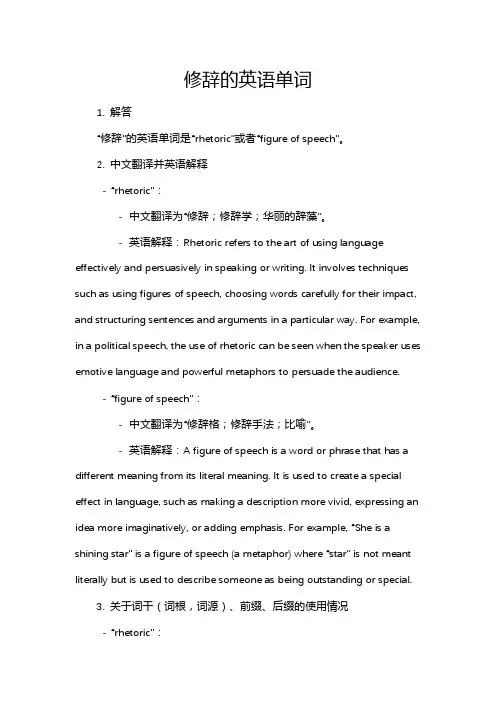
修辞的英语单词1. 解答“修辞”的英语单词是“rhetoric”或者“figure of speech”。
2. 中文翻译并英语解释- “rhetoric”:- 中文翻译为“修辞;修辞学;华丽的辞藻”。
- 英语解释:Rhetoric refers to the art of using language effectively and persuasively in speaking or writing. It involves techniques such as using figures of speech, choosing words carefully for their impact, and structuring sentences and arguments in a particular way. For example, in a political speech, the use of rhetoric can be seen when the speaker uses emotive language and powerful metaphors to persuade the audience.- “figure of speech”:- 中文翻译为“修辞格;修辞手法;比喻”。
- 英语解释:A figure of speech is a word or phrase that has a different meaning from its literal meaning. It is used to create a special effect in language, such as making a description more vivid, expressing an idea more imaginatively, or adding emphasis. For example, “She is a shining star” is a figure of speech (a metaphor) where “star” is not meant literally but is used to describe someone as being outstanding or special.3. 关于词干(词根,词源)、前缀、后缀的使用情况- “rhetoric”:- 词源:它源自于希腊语“rhetorike”,表示“演讲的艺术”。
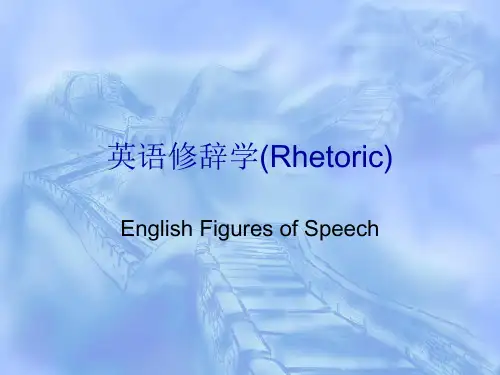
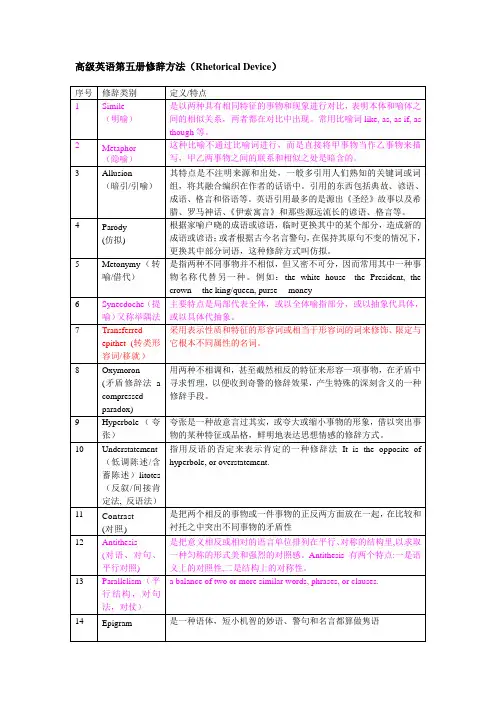
高级英语第五册修辞方法(Rhetorical Device)1. Simile:L1-17: It is something like… behind bars.L1-25: Let us be dissatisfied until from every city hall… a mighty stream.(justice will roll down like waters and righteousness like a mighty stream)L5-5: Same age, same background, but dumb as an ox. (dumb as an ox)L5-50: First he looked at the coat with the expression of a waif at a bakery window. (comparing his longing for the raccoon coat with the expression of a hungry homeless child looking longingly at the bread at a bakery window.)L5-123: It was like digging a tunnel. (comparing his teaching to the hard work of digging a tunnel.)L5-147: I leaped to my feet, bellowing like a bull. (comparing his angry shouts to the bellowing ofa bull)L7-2: …united with others of our country in everything…like the fingers of the hand.(comparing the relationship between black and white to fingers of the hand)L7-10: Yet even then I had been going over my speech...as bright as flame. (comparing each word of his speech to bright flame)L7-16: For in those days I was what they called ginger—colored...like a crisp ginger cookie.(comparing the narrator to a cookie)L7-20: My saliva became like hot bitter glue.L7-21: The boys groped about like blind, cautious crabs... hypersensitive snails. (comparing the black boys to animals)L7-27: A blow to my head as I danced about sent my right eye popping... my dilemma.L7-45: I roiled away as a fumbled football rolls off the receiver’s fingertips...L7-46: 1 was limp as a dish rag.2. Metaphor:L1-5: Psychological freedom. . . physical slavery. (the long night of physical slavery)L1-5: The Negro. . . his own emancipation proclamation. (“signs with the pen and ink of assertive manhood his own emancipation proclamation”)L1-14: … when the unjust… is eliminated. (measurement, a scale of dollars)L1-20: He who hates… ultimate reality. (owning a key to open a door)L1-25: the battering rams of the forces of justice;the junk heaps of historyLet us be dissatisfied until the tragic walls… the forces of justice. (“the tragic walls” and “the battering rams”)L1-27: When our days…into bright tomorrow. (low-hovering clouds of despair; gigantic mountains of evil)L4-3: Killing the Angel in the HouseL4-5: The image of a fishermanL4-7: A room of one’s ownL5-1: There follows an informal essay that ventures even beyond Lamb’s frontier. (comparing the limitation set by Lamb to a frontier)L5-20: My brain, that precision instrument, slipped into high gear. (Mixed metaphor, comparing at the same time the narrator’s brain to a precision instrument and also to a machine that has gears.)L5-34: In other words, if you were out of the picture, the field would be open. (comparing the competing for friendship to an athletic event)L5-98: Maybe somehow I could fan them into flame. Maybe somewhere in the extinct crater of her mind, a few embers still smoldered. (comparing Polly’s mind to the extinct crater of a volcano)L5-115: Poisoning the well: (comparing “the personal attack on a person holding some thesis” to “poisoning the well”)L5-151: The rat. (comparing Petey to a rat)L6-41: I’ve never met anyone… the second time around. (The metaphor of record player is used.)3. Allusion:L1-25: Let us be dissatisfied until that day… none shall be afraid. (a biblical allusion: the 1ion and the lamb shall lie down together; every man will sit under his own vine and fig tree and none shall be afraid)L5-64: We went to the Knoll, the campus trysting place, and we sat down under an old oak… (An implied allusion to Robin Hood, whose trysting place was under a huge oak tree in Sherwood Forest.)L5-138: I was not Pygmalion; I was Frankenstein, and my monster had me by the throat.L10-8: Overnight… surreal episodes…(a sword of Damocles)4. Parody:L10-25: Is our democracy… of liberty? (This is a parody of a line in Patrick Henry’s speech: “Is life so dear or peace so sweet, as to be purchased at the price of chains and slavery?”)5. Metonymy:L4-1: No demand was made upon the family purse. (“purse” stands for money)L4-2: But to show you how little I deserve to be called a professional woman…with my neighbors. (Butcher’s bills stand for meat bought from a butcher. )L5-23: She was, to be sure, a girl who excited the emotions. But 1 was not one to let my heart rule my head. (to let my heart rule my head: Metonymy. “Heart”stands for “feelings and emotions” and “head” for “reason and good sense”.)L5-105: …surgeons have X-rays to guide them during an operation. (X-rays stand for X-rays photographs)L10-2: Anthrax panic… chambers (“Congress” stands for its members)6. Synecdoche:L1-25: Let us be dissatisfied until from every city hall… a mighty stream.city hall (the naming of a part to mean the whole. Here, the naming of the building for the government)L4-2: But to show you how little I deserve to be called a professional woman…with my neighbors. (bread and butter: This set phrase means food and the most important and basic things. )7. Transferred epithet:L1-25: Let us be dissatisfied until the tragic walls… the forces of justice. (the tragic walls)L5-40: I said with a mysterious wink… (the wink was not mysterious)L7-6: our bare upper bodies touching and shining with anticipatory sweat (In “anticipatory sweat”, the adjective “anticipatory “ is a transferred epithet.)L7-25: He kept coming, bringing the rank sharp violence of stale sweat. (the rank sharp violence: Logically rank and sharp modify “stale sweat”, not “violence”.)8. Oxymoron:9. Hyperbole:L5-5: It is not often that one so young has such a giant intellect. (exaggerating for effect)L5-50: … he just stood and stared with mad lust at the coat. (It’s an exaggeration to describe his longing for the coat as “mad lust”)L5-135: You are the whole world to me, and the moon and the stars and the constellations of outer space.L5-135: I will wander the face of the earth, a shambling, hollow-eyed hulk.10. Understatement or litotes:L5-61: This loomed as a project of no small dimensions, and at first 1 was tempted to give her back to Petey. (no small dimensions)11. Contrast:L3-22: A contrast is made between old Shanghai and Shanghai in the 1990s.L8-3: While Oppenheimer was interrupting…. had invented the subject. (an implied contrast)L10-25: How do we… poise? (paranoia vs. poise)12. Antithesis:L1-5: As long as. . . can never be free. (mind vs. body, enslaved vs. free)L1-5: Psychological freedom. . . physical slavery. (psychological freedom vs. physical slavery)L1-7: …love is identified… denial of love (1ove vs. power, a resignation of power vs. denial of love)L1-19: For through violence… but you can’t murder hate. (You may murder a murderer but you can’t murder murder.)L1-25: outer city of wealth and comfort vs. inner city of poverty and despair;wealth vs. poverty (economic);comfort vs. despair(mood, psychology)dark yesterdays vs. bright tomorrows;segregated schools vs. integrated educationon the basis of the content of their character vs. on the basis of the color of their skincontent(substance) vs. color (superficial)character(fundamental) vs. skin (outward appearance)L1-27: When our days…into bright tomorrow.dark yesterday VS. bright tomorrowL5-27: It is, after all, easier to make a beautiful dumb girl smart than to make an ugly smart girl beautiful.beautiful dumb vs. ugly smartL5-50: Back and forth his head swiveled, desire waxing, resolution waning.Desire waxing vs. resolution waningL5-153: Look at me—a brilliant student, a tremendous intellectual, a man with an assured future.Look at Petey—a knot-head, a jitterbug, a guy who’ll never know where his next meal is coming from.Brilliant, intellectual and assured vs. knot-head, jitterbug and never know where his next meal is coming from”13. Parallelism:L1-6: … confrontation of the forces… the status quo.forces of power demanding change(present participle)forces of power dedicated to the preserving of the(past participle) status quoL1-8: What is needed… and anemic.power without love is reckless and abusivelove without power is sentimental and anemicL1-8: Power at its best… against love.power at its best love implementing demands of justicejustice at its best power correcting against loveL1-10: And, in the thinking of that day…moral fiber.the absence of vs. a want ofworldly goods vs. (qualities)L1-19: For through violence… but you can’t murder hate.Three sentences “T hrough violence you may murder… but you can’t murder…”L1-20: And I have seen too much hate…. too great a burden to bear.I have seen too much hateI’ve seen too much hate onI’ve seen hate on…too many Klansmen…L1-25: There are 11 sentences beginning with “let us be dissatisfied until” and two short sentences of “let us be dissatisfied”.L12-5: The armies of… The legions of…The armies of… are marshaled against it.The legions of… will march against it.L12-16: A novelist’s characters… celebrity.a novelist’s characters hope for immortalitya profile journalist’s for celebrityL12-24: It is the disrespect… to preserve.(disrespect) for powerorthodoxiesparty linesideologies…;that I would like to celebratethat I urge all to preserve14. Epigram:L1-20: He who hates… ultimate reality.15. Paradox:L1-18: Without recognizing this…that don’t explain.paralleled paradoxes: solutions that don’t solveanswers that don’t answerexplanations that don’t explainL1-27: When our days…into bright tomorrow. (to make a way out of no way)16. Chiasmus:L1-9: It is precisely this collision… of our times. (immoral power vs. powerless morality)L6-6: Absence of evidence is not evidence of absence.17. Anaphora:L1-25: let us be dissatisfied…18. Alliteration:L1-25: Let us be dissatisfied until that day… none shall be afraid. ( lion, lamb, lie)L7-2: Live with your head in the lion’s mouth...or bust wide open. (death and destruction)L7-9: Some of the others tried to stop them…slipping and sliding over the polished floor.(slipping and sliding)19. Onomatopoeia:L3-14: clickRhetorical Devices一、明喻(simile)是以两种具有相同特征的事物和现象进行对比,表明本体和喻体之间的相似关系,两者都在对比中出现。
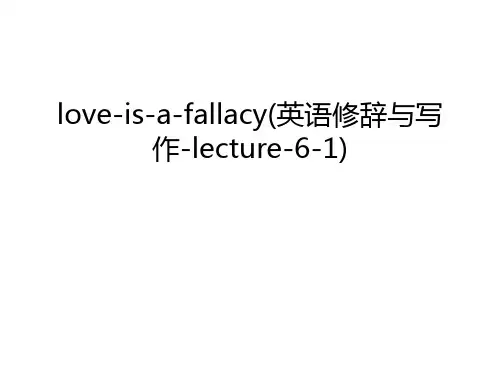
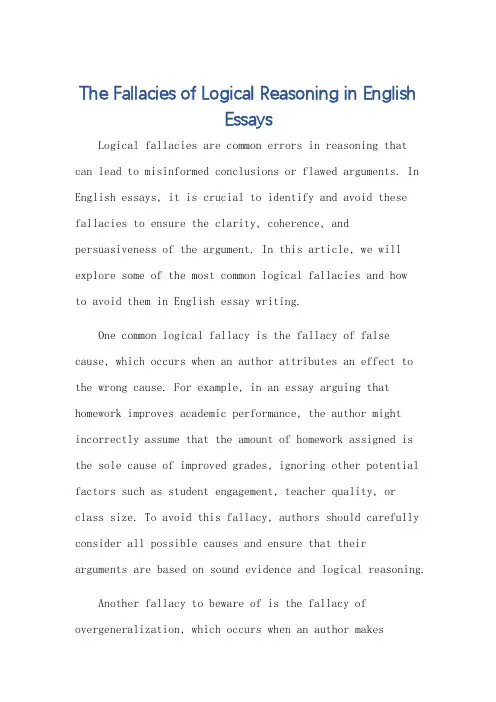
The Fallacies of Logical Reasoning in EnglishEssaysLogical fallacies are common errors in reasoning that can lead to misinformed conclusions or flawed arguments. In English essays, it is crucial to identify and avoid these fallacies to ensure the clarity, coherence, and persuasiveness of the argument. In this article, we will explore some of the most common logical fallacies and howto avoid them in English essay writing.One common logical fallacy is the fallacy of false cause, which occurs when an author attributes an effect to the wrong cause. For example, in an essay arguing that homework improves academic performance, the author might incorrectly assume that the amount of homework assigned is the sole cause of improved grades, ignoring other potential factors such as student engagement, teacher quality, orclass size. To avoid this fallacy, authors should carefully consider all possible causes and ensure that their arguments are based on sound evidence and logical reasoning. Another fallacy to beware of is the fallacy of overgeneralization, which occurs when an author makessweeping generalizations based on limited evidence. For instance, in an essay discussing the impact of social media on mental health, an author might overgeneralize by claiming that all social media use is harmful, despite the fact that the research may only support a correlation between excessive use and certain negative outcomes. To prevent this fallacy, authors should carefully consider the scope and limitations of their evidence and avoid making blanket statements that lack nuance and consideration.Additionally, the fallacy of ad hominem is a common logical fallacy in which an author attacks the character or motives of their opponent instead of addressing their arguments. For instance, in an essay debating the merits of a particular policy, an author might resort to personal insults or accusations to discredit their opponent's position instead of providing logical reasons to support their own view. To avoid this fallacy, authors should focus on the substance of the argument and present logical reasons to support their claims, rather than resorting to personal attacks.Lastly, the fallacy of the red herring occurs when an author introduces irrelevant information to distract from the main issue at hand. For example, in an essay discussing the impact of climate change on global warming, an author might introduce a tangent about the economic costs of implementing sustainable practices to deflect attention from the main argument. To prevent this fallacy, authors should stay focused on the central issue and avoid introducing irrelevant or distracting information that does not contribute to the overall argument.In conclusion, logical fallacies can significantly undermine the effectiveness of an English essay. By being aware of common fallacies such as the fallacy of false cause, overgeneralization, ad hominem attacks, and the red herring, authors can ensure that their arguments are based on sound evidence and logical reasoning. By avoiding these fallacies, authors can craft more coherent, persuasive, and impactful essays that effectively communicate their ideas and positions.**逻辑谬误在英语作文中的体现**逻辑谬误是推理中常见的错误,可能导致误导性的结论或错误的观点。
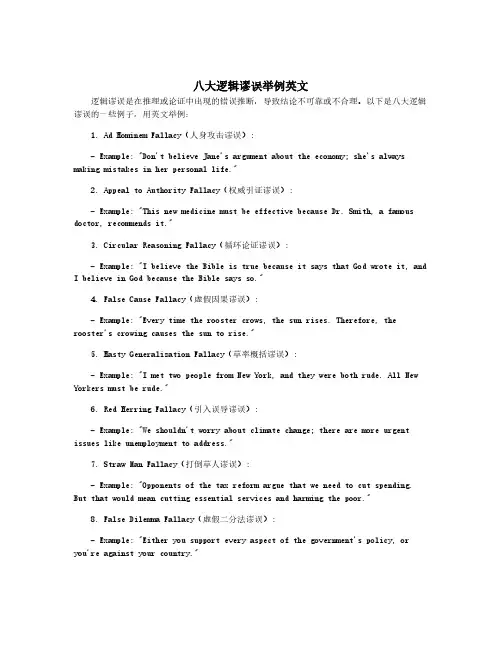
八大逻辑谬误举例英文逻辑谬误是在推理或论证中出现的错误推断,导致结论不可靠或不合理。
以下是八大逻辑谬误的一些例子,用英文举例:1.Ad Hominem Fallacy(人身攻击谬误):-Example:"Don't believe Jane's argument about the economy;she's always making mistakes in her personal life."2.Appeal to Authority Fallacy(权威引证谬误):-Example:"This new medicine must be effective because Dr.Smith,a famous doctor,recommends it."3.Circular Reasoning Fallacy(循环论证谬误):-Example:"I believe the Bible is true because it says that God wrote it,and I believe in God because the Bible says so."4.False Cause Fallacy(虚假因果谬误):-Example:"Every time the rooster crows,the sun rises.Therefore,the rooster's crowing causes the sun to rise."5.Hasty Generalization Fallacy(草率概括谬误):-Example:"I met two people from New York,and they were both rude.All New Yorkers must be rude."6.Red Herring Fallacy(引入误导谬误):-Example:"We shouldn't worry about climate change;there are more urgent issues like unemployment to address."7.Straw Man Fallacy(打倒草人谬误):-Example:"Opponents of the tax reform argue that we need to cut spending. But that would mean cutting essential services and harming the poor."8.False Dilemma Fallacy(虚假二分法谬误):-Example:"Either you support every aspect of the government's policy,oryou're against your country."这些例子帮助说明了逻辑谬误是如何在不同的情境中发生的,以及它们为什么会导致不可靠的推理。
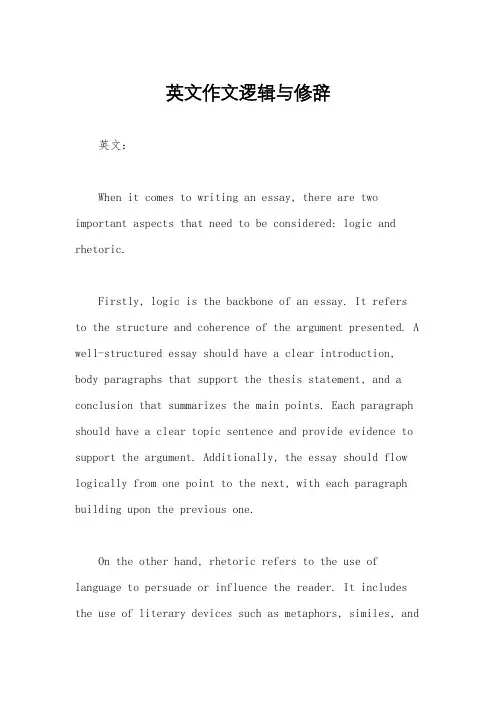
英文作文逻辑与修辞英文:When it comes to writing an essay, there are two important aspects that need to be considered: logic and rhetoric.Firstly, logic is the backbone of an essay. It refers to the structure and coherence of the argument presented. A well-structured essay should have a clear introduction, body paragraphs that support the thesis statement, and a conclusion that summarizes the main points. Each paragraph should have a clear topic sentence and provide evidence to support the argument. Additionally, the essay should flow logically from one point to the next, with each paragraph building upon the previous one.On the other hand, rhetoric refers to the use of language to persuade or influence the reader. It includes the use of literary devices such as metaphors, similes, andpersonification, as well as the use of persuasive language and emotional appeals. A well-written essay should not only present a logical argument, but also engage the reader and evoke an emotional response.For example, consider the following sentence: "The sun was shining brightly." This sentence is straightforward and factual, but it does not engage the reader. However, if we use a simile and say "The sun was shining like a diamond in the sky," it not only provides a visual image for the reader, but also makes the sentence more interesting and engaging.In conclusion, both logic and rhetoric are important aspects of writing an effective essay. While logic provides the structure and coherence of the argument, rhetoric adds depth and engagement to the writing.中文:写作文章时,需要考虑两个重要方面,逻辑和修辞。
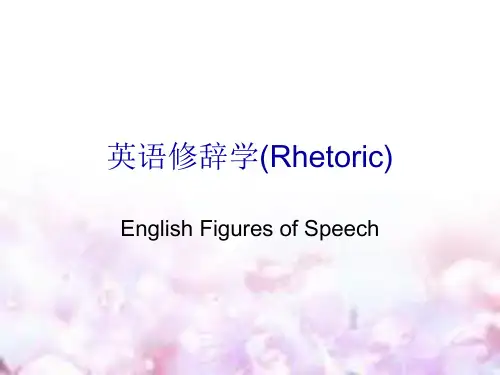
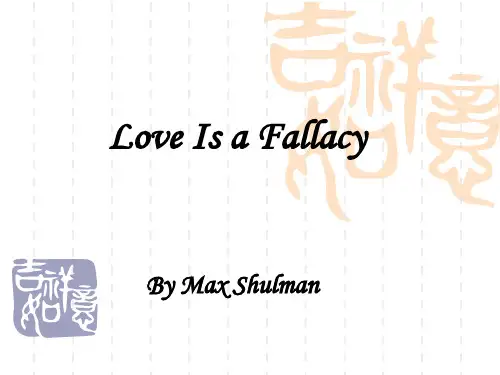
An Introduction to Figures of Speech(修辞格)Rhetorical Devices(修辞手法)1. Simile(明喻)Simile is an expression of comparison between two different things. It is usually introduced by “as” or “like”, and sometimes also by “as…as/as…so”, and “resemble”as the signs of comparison.明喻就是打比方,指一事物像另一事物的修辞格。
常用的比喻词有“as”or “like”, and sometimes also by “as…so /as…as”, and “resemble”等1). Mercy drops as the gentle rain from heaven upon the place beneath.—Shakespeare2). The cheque fluttered to the floor like a bird with a broken wing.3). Self-criticism is as necessary to us as air to water.4). As a man whispers, so the breeze makes a low, hissing sound.5) Learning resembles scaling the heights.2. Metaphor(隐喻/暗喻)Metaphor contains an implied comparison, in which a word or phrase ordinarily or primarily used of one thing is applied to another. In other words, it calls one thing by the name of another or one thing is described in terms of another.隐喻是一种隐含着比喻的修辞格,它直接把一种事物比为另一种事物,不用比喻词,通常比较含蓄。